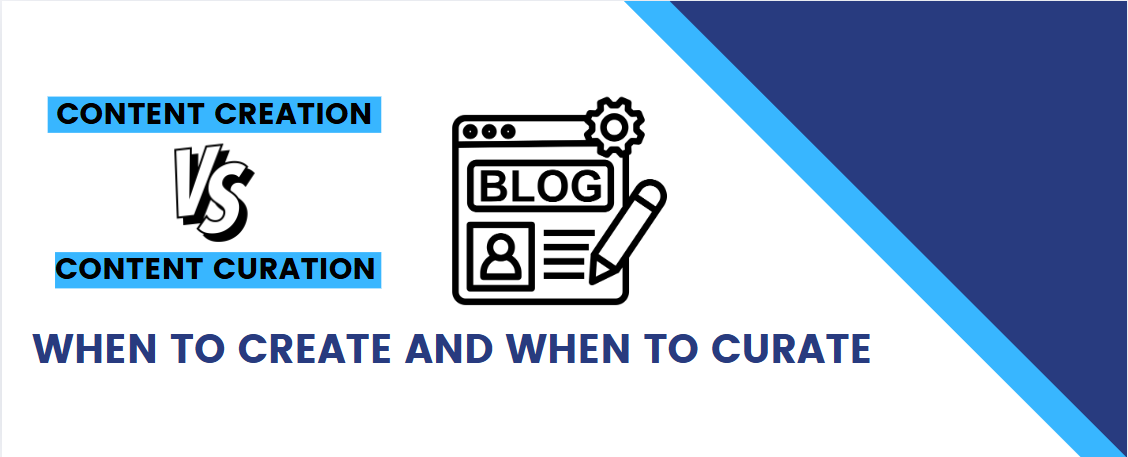In today’s digital age, content is king. Whether you’re running a business, building a personal brand, or just trying to stay relevant on social media, creating and sharing content is essential. But here’s the big question: should you create content from scratch, or should you curate content from other sources? Both strategies are important, but knowing when to do each can be tricky.
Let’s break it down: Content Creation and Content Curation are two terms you often hear thrown around. But what exactly do they mean, and when should you use them? Let’s dive into these concepts with easy-to-understand examples and real-life stats to guide your decision-making process.
What is Content Creation?
Content creation is the process of producing original content. This includes things like blog posts, videos, podcasts, infographics, or social media posts that you make yourself, usually from scratch. The goal is to provide something new and valuable to your audience.
Why Is Content Creation Important?
Content creation allows you to establish authority in your field and connect directly with your audience. According to HubSpot, 70% of marketers are actively investing in content marketing, which shows just how important content creation is to building brand recognition and trust.
Example: A YouTube video where you demonstrate how to make a chocolate cake from scratch is original content. You’ve filmed it, edited it, and shared it with your audience.
When Should You Focus on Content Creation?
Content creation is best when you need to:
- Build your brand’s voice and authority: If you’re trying to establish yourself or your business as an expert in a particular area, creating original content is key. People will come to you for fresh ideas and insights.
- Tell your unique story: No one else can share your experiences or perspective the way you can. If your goal is to stand out, original content gives you a chance to tell your own narrative.
- Drive traffic and SEO: Search engines like Google love fresh, high-quality content. According to Content Marketing Institute, companies that prioritize blogging are 13x more likely to see a positive ROI on their marketing efforts. Creating original blog posts, videos, or infographics with targeted keywords helps boost your website’s search rankings.
- Engage with your audience directly: Original content allows you to have a conversation with your audience and respond to their specific needs and preferences.
What is Content Curation?
Content curation, on the other hand, involves gathering, organizing, and sharing content created by others. The goal is not to create something from scratch, but rather to find and share valuable information that’s already out there.
Why Is Content Curation Important?
Content curation allows you to stay active on your platforms without always having to produce original material. It’s a great way to provide value to your audience without the pressure of always creating new content. It also helps you stay informed and up-to-date with the latest trends in your industry.
Stat Alert: According to a report by Curata, 60% of marketers say content curation helps improve brand awareness, while 42% say it drives website traffic.
Example: You might share an interesting article or video on Twitter about the latest trends in technology, but the article was written by someone else. You’re curating, not creating.
When Should You Focus on Content Curation?
Content curation is ideal when you need to:
- Save time: If you don’t have the resources or time to produce original content consistently, curating content allows you to stay active without a heavy investment of time or money.
- Provide a variety of perspectives: Curating content from multiple sources gives your audience a broader view of a topic, rather than just your perspective.
- Build relationships with other creators: When you share someone else’s content, it’s an opportunity to connect with other influencers in your niche. If you share their content, they might return the favor, increasing your visibility.
- Establish yourself as a thought leader or trusted source: By curating high-quality content from top sources, you can position yourself as someone who knows the best information out there, even if you didn’t create it yourself.
Content Creation vs. Content Curation: A Statistical Comparison
Let’s take a deeper dive into how both content creation and curation stack up, backed by some real-world stats.
- Time and Resource Investment:
- Content creation can take a lot of time. For instance, writing a blog post could take anywhere from 1-4 hours depending on the topic and depth. For videos, you’re looking at hours of filming and editing before you can publish.
- Content curation takes less time. You’re spending time searching, organizing, and sharing, but not producing everything from scratch. Curata’s research suggests that 40% of marketers believe content curation saves them time.
- SEO and Organic Reach:
- Content creation is crucial for SEO. Google loves fresh, original content. According to Neil Patel, fresh content drives up organic traffic. Websites that publish fresh blog posts consistently generate 55% more traffic.
- Content curation is more about amplifying others’ content. However, curating and sharing quality content still helps with SEO indirectly. Curating helps you stay visible and share relevant content with your audience.
- Audience Engagement:
- Content creation generally results in higher engagement because people come to you for your unique perspective and expertise.
- Content curation can still spark discussions but often results in lower engagement compared to original content. This is because curated content typically doesn’t have the same emotional pull as something you’ve created from scratch.
- ROI (Return on Investment):
- Content creation typically offers a higher long-term ROI because it helps with brand building, lead generation, and customer retention. According to Demand Metric, content marketing (which includes creation) can generate 3x the leads at 62% lower cost than traditional marketing.
- Content curation can provide quick wins in terms of engagement and sharing, but it doesn’t necessarily build long-term brand loyalty. That said, curating high-quality, relevant content can still drive ROI by increasing website traffic and brand awareness.
When Should You Create Content vs. Curate Content?
The real question is: How do you know when to create and when to curate? Here’s a simple guide to help you decide.
When to Create Content:
- When you want to establish a unique brand identity: If you want your audience to connect with your specific point of view or expertise, create original content.
- When there is a content gap: If you notice that no one is covering a particular topic in-depth, creating original content on that subject will set you apart.
- When SEO is a priority: Creating high-quality, keyword-rich content improves your website’s visibility and rankings in search engines. If you want to rank for specific keywords, original content is a must.
- When your goal is long-term growth: Building a strong brand presence through consistent, high-quality original content can pay off in the long term.
When to Curate Content:
- When you want to stay active without a heavy workload: If you don’t have the time or resources to create new content regularly, curating content helps you stay visible.
- When you want to provide value quickly: Curating content from reputable sources can be a quick way to provide valuable information to your audience without much effort.
- When you want to share multiple perspectives on a topic: If you want to offer your audience a variety of opinions and insights, curating content from several sources is the way to go.
- When you want to connect with others: Curating content is an easy way to network with other content creators. Sharing their content might lead to collaborations or partnerships.
A Balanced Strategy: The Best of Both Worlds
Ultimately, the most successful content strategy combines both creation and curation. In fact, Curata’s study found that 78% of top-performing content marketers use a combination of content creation and curation to get the best results.
Here’s how you can blend both:
- Create core, in-depth content (e.g., blog posts, white papers, case studies) that highlights your expertise.
- Curate relevant content from thought leaders, influencers, and other sources that complement your own content. Share it on social media, in newsletters, or within your community.
By mixing content creation and curation, you’re building a well-rounded strategy that ensures you’re engaging your audience without burning yourself out.
Conclusion
In the end, there’s no one-size-fits-all answer to whether you should create or curate content. Both approaches have their place and offer unique benefits. Content creation helps you build your voice, authority, and SEO presence, while content curation lets you stay active, share different perspectives, and save time.
By understanding when to use each strategy and finding the right balance between the two, you can maximize your content marketing efforts and keep your audience engaged and coming back for more. Whether you’re creating original content, curating the best of what others offer, or doing a little bit of both, remember that content is always about providing value. So, choose the right strategy, and get creating (or curating)!


